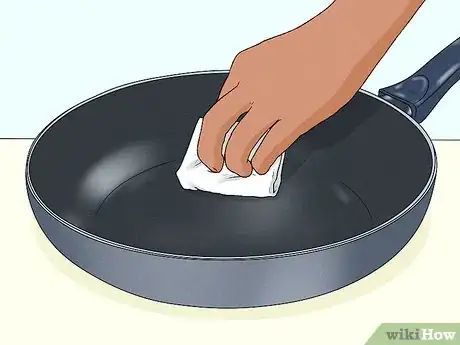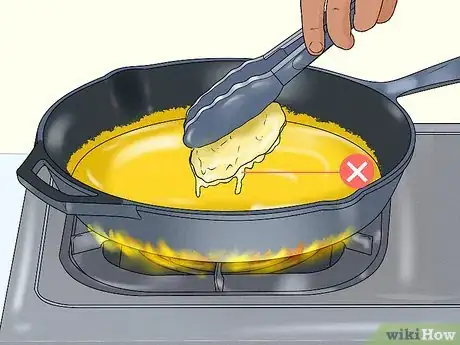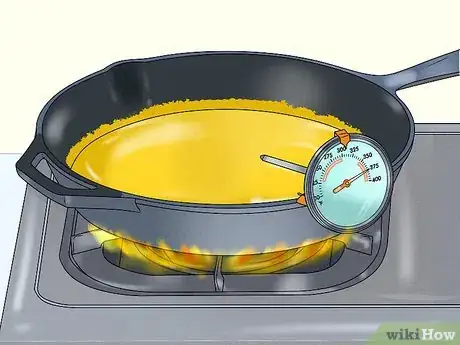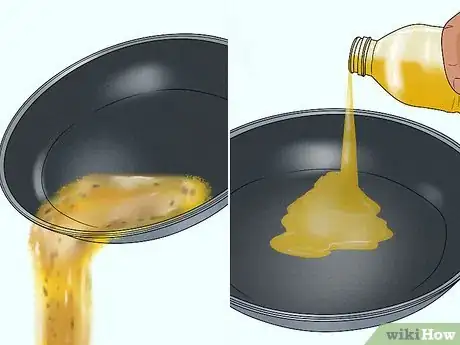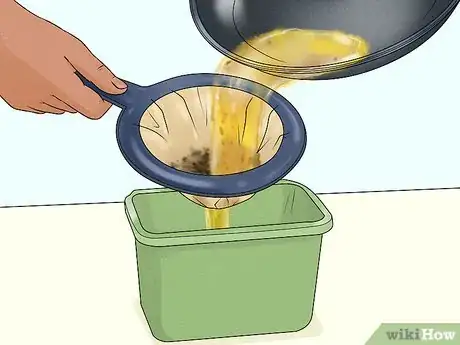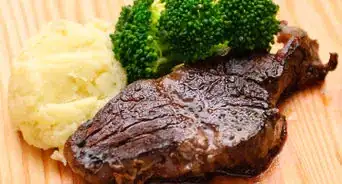This article was co-authored by Marrow Private Chefs and by wikiHow staff writer, Hannah Madden. Marrow Private Chefs are based in Santa Rosa Beach, Florida. It is a chefs’ collaborative comprised of an ever-growing number of chefs and culinary professionals. Though regionally influenced primarily by coastal, traditional southern, cajun, and creole styles and flavors, the chefs at Marrow have a solid background in all types of cuisine with over 75 years of combined cooking experience.
This article has been viewed 27,270 times.
Frying up your own food to enjoy at home is one of life’s greatest pleasures. Seeing a layer of scummy foam on top of your oil, however, can detract from your delicious food quite a bit. There are a few different reasons why your fry oil might be foaming up, so you can try out a couple of methods to see what makes your oil calm down again. If your oil smells fishy and foams up a lot, it might be time to pour it out and start fresh.
Steps
Before Frying
-
1Rinse your frying vessel well before you use it. Old oil and bits of food can linger in your frying vessel, leading to smokey, foamy oil. Before you start a fresh batch, give your frying vat a good rinse with hot water to clear out any unwanted leftovers.[1]
- It’s a good idea to clean out your frying vessel every time you use it. That way, you can avoid an oil buildup that could get smelly and gross.
-
2Clean your frying vats with hot water, not soap. Leftover soap and detergent can react with your hot oil and cause it to foam up (plus, it makes the oil taste pretty bad). To prevent that from happening, stick to cleaning out your frying vessels with hot water only, not dish soap or detergent.[2]
- Leftover soap can also make your oil smoke, leading to strange-tasting food and wasted oil.
Advertisement -
3Dry your fry vessel well. Too much water inside your frying vessel could lead to bubbling or foaming oil. Before you use your deep fryer, make sure the inside is clean and dry to prevent any issues as you fry.[3]
- Bubbling oil is very dangerous, especially when it heats up. The less water you introduce to hot oil, the better.
-
4Use an oil specifically for deep frying. Low quality oils that aren’t made for frying usually have a lot of moisture, which can lead to foaming as they heat up. Go for peanut oil or canola oil to fry your food up deliciously and safely.[4]
- Using the wrong oil can also make your food taste slightly off. Peanut oil and canola oil don’t add any flavor to your food, so the natural taste shines through instead of the greasy oil.
-
5Make sure your battered items aren’t dripping with batter. Too much batter on your food pieces can overload your oil and make it spit or foam up. If you are battering your food, only add 1 to 2 coatings, and make sure your food isn’t dripping with batter before you dip it into the fryer.[5]
- This will also prevent large chunks of batter breaking off and floating around in your oil, which can make your oil last longer and taste better.
-
6Pat the food dry before you fry it. If you aren’t battering your food, use a paper towel to dab off any excess water. Frying food with water on it can not only make it foam up, but it can cause the oil to bubble and spit, too.[6]
- This is especially important for starchy foods (like potatoes) that can hold a lot of water.
During and After Frying
-
1Avoid heating the oil up too much. Once your oil reaches the perfect temperature for frying—usually around 375 °F (191 °C)—keep the heat steady or turn it down just a touch. If the oil gets too hot, it could start to bubble and foam, so you should try to keep the temperature as steady as possible.[7]
- To track your oil temperature, put a deep fry thermometer in your oil to make sure it’s hot enough to cook with.
- Fry small quantities of food to prevent foaming.
-
2Skim out any particles in between batches. If you’re frying a lot of food and you notice a lot of chunks getting left behind, they could be causing the foam on top of your oil. Use a slotted spoon to scoop out the big pieces of batter, then throw them away.[8]
- Big chunks of floating batter can also lower the temperature of your oil over time, so it’s best to just get them out of there.
-
3Change out the oil if it’s old. Sometimes, foaming oil can be an indication that your oil has gone bad. If the foam is accompanied by a rotten fish smell, your oil has probably gone rancid. Pour it into a plastic container and throw the container into the trash.[9]
- Cooking food in rancid oil can make you really sick. In general, it’s best not to reuse your oil more than 2 to 3 times.
-
4Turn off your frying vats when you aren’t using them. Heating up your oil too much can lead to oxidation, which can turn your oil foamy. If you aren’t using your fryer, turn the heat off and let the oil cool to make sure it doesn’t foam or spit.[10]
- Getting your oil up to temperature can take a while, so only turn off your fryers if you’re absolutely sure you’re done!
-
5Filter the oil to keep it clean. If you want to reuse your oil later on, turn off the heat and let your oil cool down. Once the oil is cool, put a fine mesh strainer and a coffee filter on top of a plastic container, then slowly pour your oil through. Throw away any large chunks left in the coffee filter, then store your oil in a cool, dark place in your kitchen.[11]
- Straining your oil can take a long time. If you’d like a speedier method, mix together 1⁄4 cup (59 mL) of water and 1 tbsp (14 g) of cornstarch for every 1 c (240 mL) of fry oil you used. Stir the mixture into your oil and heat it slowly for 10 to 12 minutes, then pour it through a fine mesh strainer before storing. The cornstarch helps to trap the solids in one place, making it easier to strain and pour.
Warnings
- Always put out a grease fire with a fire extinguisher, salt, or baking soda. Never use water, as that will only make the flames bigger.[12]⧼thumbs_response⧽
Expert Interview
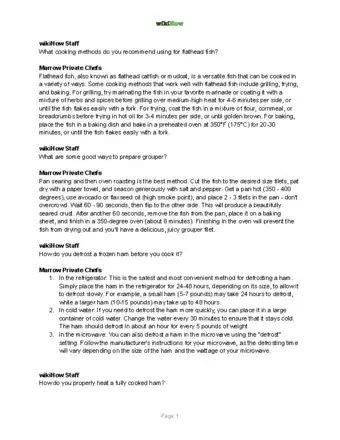
Thanks for reading our article! If you'd like to learn more about preventing oil from foaming, check out our in-depth interview with Marrow Private Chefs.
References
- ↑ https://www.rti-inc.com/wp-content/uploads/2016/08/RT0047-Oil_Infographic.pdf
- ↑ https://www.rti-inc.com/wp-content/uploads/2016/08/RT0047-Oil_Infographic.pdf
- ↑ https://www.rti-inc.com/wp-content/uploads/2016/08/RT0047-Oil_Infographic.pdf
- ↑ https://www.hennypenny.com/wp-content/uploads/2018/03/FM05-050-H_LVG-10x_Ops_Mc_English.pdf
- ↑ https://www.restaurantbusinessonline.com/advice-guy/why-my-fryer-oil-foamy
- ↑ https://www.restaurantbusinessonline.com/advice-guy/why-my-fryer-oil-foamy
- ↑ https://www.restaurantbusinessonline.com/advice-guy/why-my-fryer-oil-foamy
- ↑ https://www.restaurantbusinessonline.com/advice-guy/why-my-fryer-oil-foamy
- ↑ https://www.fsis.usda.gov/wps/wcm/connect/65f762d0-e4d0-4278-b5cb-2836854a3eda/Deep_Fat_Frying.pdf?MOD=AJPERES


